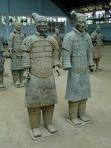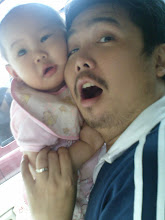 The Terra-Cotta Army of the Qin Dynasty is China's rare historical relics, enjoying worldwide fame. They are the works made by craftsmen some 2,200 years ago and have been listed as "the eighth wonder of the world". The Terra-Cotta Army is the funeral objects in Emperor Qin Shi Huang's mausoleum. As most of the works are soldier and horse figures, they are also called "soldier and horse figures of the Qin Dynasty".
The Terra-Cotta Army of the Qin Dynasty is China's rare historical relics, enjoying worldwide fame. They are the works made by craftsmen some 2,200 years ago and have been listed as "the eighth wonder of the world". The Terra-Cotta Army is the funeral objects in Emperor Qin Shi Huang's mausoleum. As most of the works are soldier and horse figures, they are also called "soldier and horse figures of the Qin Dynasty".In the spring of 1974, when some peasants were digging a well in Lintong County of Shaanxi Province, they came across the secret of the Terra-Cotta Army - a huge army of troops underground. Life-size soldiers and horses made of pottery were lined in orderly ranks, as if ready for the emperor's inspection. A total of over 7,000 pottery soldiers, more than 100 chariots, 4,000-plus pottery horses and as many as over 100,000 weapons were found in three pits of the mausoleum. Bronze weapons like swords, spears, halberds and rocked blades unearthed f rom the pits were still glistening and sharp, despite being buried underground for over 2,000 years - something of a marvelous wonder in the world metallurgical history.
rom the pits were still glistening and sharp, despite being buried underground for over 2,000 years - something of a marvelous wonder in the world metallurgical history.
The Terra-Cotta Army of the Qin Dynasty is modeled after Emperor Qinshihuang's real army. Judging by the number and making techniques of the pottery soldiers and horses, they were produced in large batches with different people working on different parts. It was a remarkable feat, given the technological conditions at that time. The creation of the Terra-Cotta Army was based on real life and used realistic expression techniques, forming a distinctive artistic style.
The exquisite pottery warriors were made with superb craftsmanship. There are subtle differences in each soldier's hairstyle, expression, clothes and even the buttons of the battle robe and the edges of the armor. These warriors are unique in Chinese sculpture history, holding high artistic values and causing a great impact on the sculptural art after the Qin Dynasty.
It is believed that the statues were destroyed only some 50 years after their original creation, due to a fire set during a peasant uprising. The original design included a wooden roof covering the rows of soldiers, and the statues were crushed when this burning roof collapsed in on them. The fire also destroyed the paint which gave the statues a more realistic look. However, the separate pit which contains the "officers" of the army escaped fire, and some paint remnants can still be seen on these figures.
Excavation and Re-construction
The statues were discovered in March 1974 during the sinking of wells for farmland irrigation construction by three local farmers, one of whom is still alive today and working at the tourist center. Professional excavation of the vaults started soon after their discovery. At the time, all of the soldiers were badly broken. A group of archaeologists are still in the process of piecing the soldiers back into their original form. It is estimated that it will be approximately 50 years before they finish the project. All the archeologists involved are native Chinese, since offers of foreign aid in the project have been refused.
Three or more vaults, measuring about 4-8 meters deep, have been excavated and a museum set up on the ruins, called Xi'an First Qin Emperor's Terracotta Army Museum (西安秦始皇兵馬俑博物館). Vault One was opened to the public in 1979, and the whole museum was completed in 1994. Currently, several vaults are open for viewing. Other vaults have been discovered but have yet to be excavated.
In 1987, UNESCO added the Terracotta Army and the Tomb of the First Qin Emperor to the list of the World Heritage Sites.
The tomb of Qin Shi Huang (located at 34°23′N 109°15′E) is near an earthen pyramid 76 meters tall and nearly 350 meters square. The tomb presently remains unopened. There are plans to seal-off the area around the tomb with a special tent-type structure to prevent corrosion from exposure to outside air. However, there is only one company in the world that makes these tents, and their largest model will not cover the site as needed.
It is thought that the tomb will contain many rooms, valuable treasures, and also the remains of the "interior designers" of the tomb, who were supposedly sealed alive inside the tomb to prevent them from telling anyone of the contents of the tomb or the location of its entrance. Also buried with Qin Shi Huang were all the women from his court who had not borne any children. Some historians believe that they were buried alive.
Magnetic scans of the land above the tomb have confirmed the legend of a great map of China, with rivers of flowing quicksilver. The scans have even shown concentrations of quicksilver where great bo dies of water would be on such a map.
dies of water would be on such a map.
In 1980 two painted bronze chariots were discovered 20 meters west of Qin Shi Huang's tomb. Consisting of 3000 parts, each of the chariots is driven by an imperial charioteer and drawn by 4 horses. According to the Han Dynasty scholar Cai Yong (蔡邕 132-192), the first chariot was for clearing the road for the Emperor's entourage, and the second was his sleeping chariot. The bridles and saddles of the horses are inlaid with gold and silver designs and the body of the number 2 chariot has its sliding windows hollow cut. Both are half life size and are now displayed in the Museum.
Did You Know?
– The chamber containing the Terra Cotta Army was discovered in 1974 by a group of farmers attempting to dig a well near the ancient capital city of Chang'an in what is today the Shaanxi Province, near the modern city of Xi'an.
– The "army" is made up of more than 6,000 figures including soldiers, horses, chariots, bowmen and archers. The figures are life-sized, and each has a unique face and details.
– The terra cotta soldiers were found arranged in military formation in large pits with rammed earth walls dividing the rows. Four main pits have been excavated: three with figures in them and one empty, suggesting that the full tomb army was not completed before the emperor's death.
– The figures were made using molds for different pieces, which were then assembled. Although the statues were originally brightly painted, the paint has since mostly flaked away.
– The tomb of the Terra Cotta Army was designated a UNESCO World Heritage site in1987. It attracts an estimated 2 million visitors each year.
Tomb Figures
In ancient China tomb figures were puppets buried with the dead, usually made of clay, wood or bronze. The most commonly seen are wood and pottery tomb figures.Scale of Qin Terracotta Figures
In Shaanxi Province, at the Museum of Qin Shi Huang's Terracotta Army, rows of exquisitely made and fired terracotta figures stand in order in the massive pit, each with a different bearing. The arrangement of the army elicits a sense of majesty and awe . More than seven thousand military clay figures, over six hundred steeds, more than 130 chariots, tens of thousands of weapons - all serve as a miniature of the Qin Army, which was over million strong. They fall into rigorous and orderly columns, ready for any military action. The terracotta formation is an awe-inspiring and majestic proclamation to defend the empire.
. More than seven thousand military clay figures, over six hundred steeds, more than 130 chariots, tens of thousands of weapons - all serve as a miniature of the Qin Army, which was over million strong. They fall into rigorous and orderly columns, ready for any military action. The terracotta formation is an awe-inspiring and majestic proclamation to defend the empire.



No comments:
Post a Comment